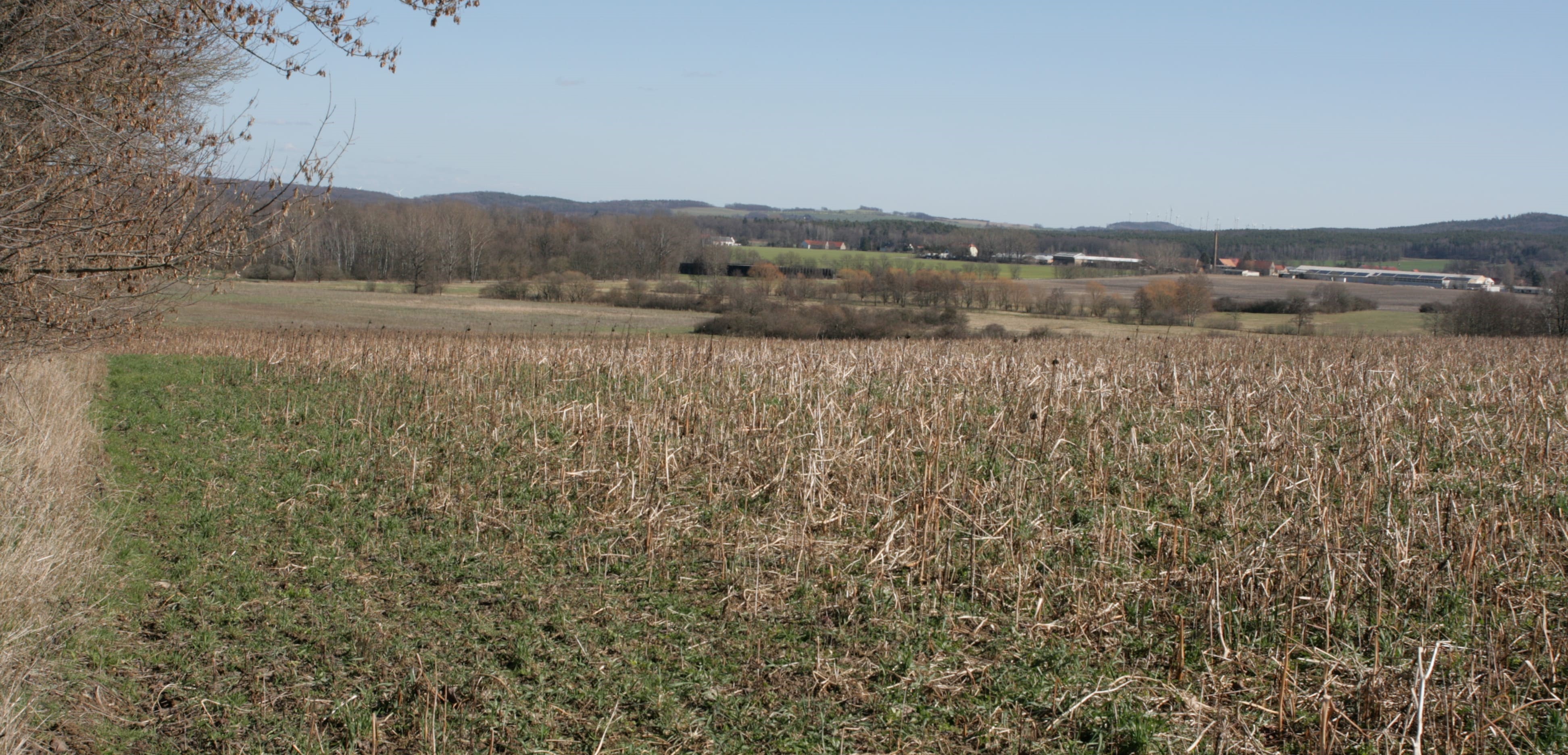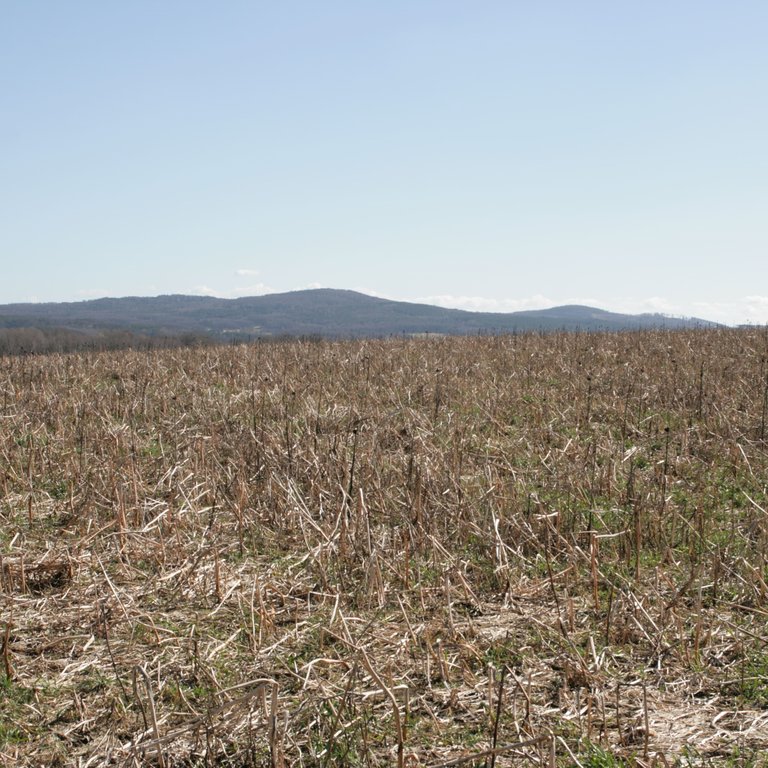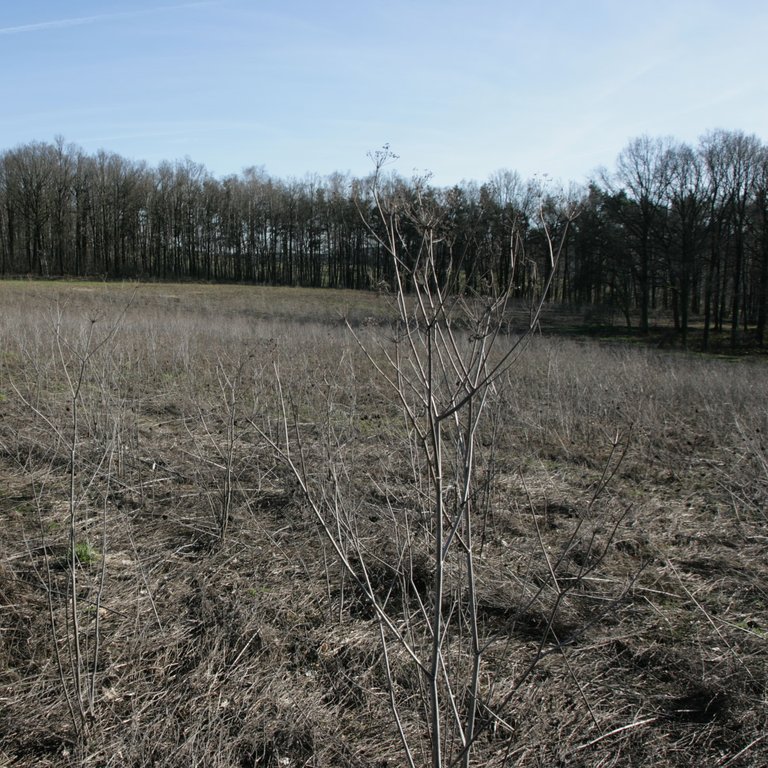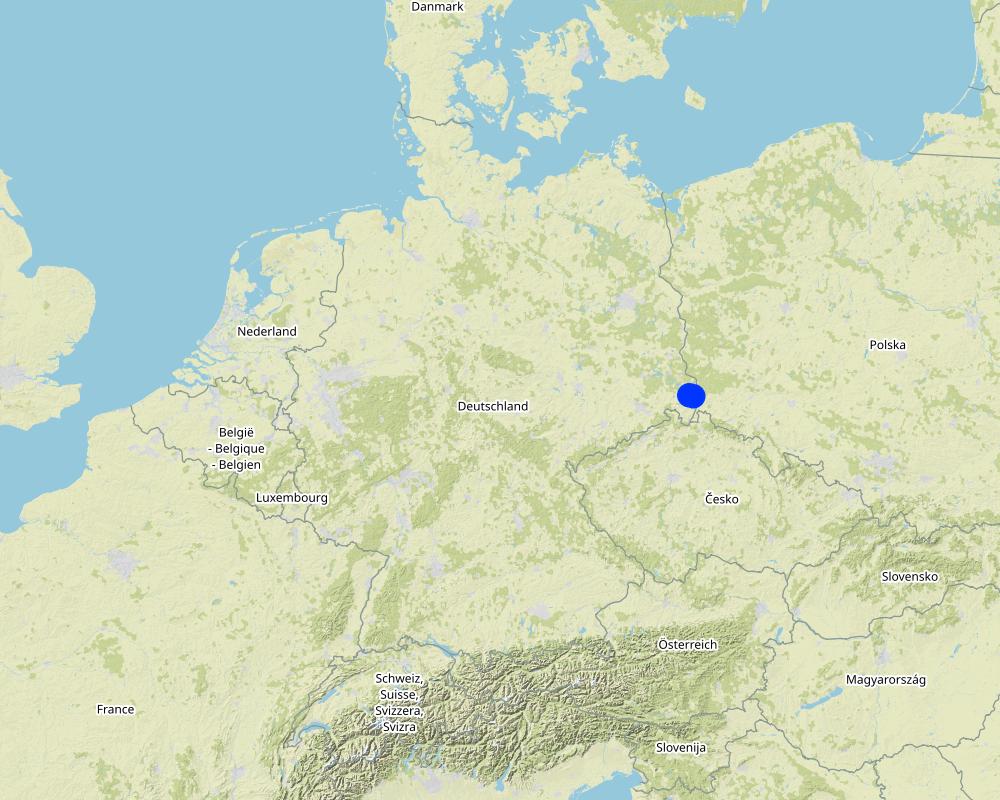Freezing winter cover crops [Germany]
- Creation:
- Update:
- Compiler: Michael Strauch
- Editors: Felix Witing, Mona Pauer
- Reviewers: William Critchley, Rima Mekdaschi Studer
Abfrierende Zwischenfrüchte
technologies_5929 - Germany
View sections
Expand all Collapse all1. General information
1.2 Contact details of resource persons and institutions involved in the assessment and documentation of the Technology
SLM specialist:
SLM specialist:
Name of project which facilitated the documentation/ evaluation of the Technology (if relevant)
OPtimal strategies to retAIN and re-use water and nutrients in small agricultural catchments across different soil-climatic regions in Europe (OPTAIN)Name of the institution(s) which facilitated the documentation/ evaluation of the Technology (if relevant)
Helmholtz Centre for Environmental Research (UFZ) - Germany1.3 Conditions regarding the use of data documented through WOCAT
The compiler and key resource person(s) accept the conditions regarding the use of data documented through WOCAT:
Yes
1.4 Declaration on sustainability of the described Technology
Is the Technology described here problematic with regard to land degradation, so that it cannot be declared a sustainable land management technology?
No
2. Description of the SLM Technology
2.1 Short description of the Technology
Definition of the Technology:
Freezing winter cover crops are planted to cover the soil rather than for the purpose of being harvested. They improve soil structure, diversify cropping systems, suppress weeds and pests, and prevent nutrient loss.
2.2 Detailed description of the Technology
Description:
In general, cover crops are divided into summer and winter cover crops. They can be used as fodder or as a biogas substrate. However, when left in the field, cover crops support the formation of humus and serve as a source of nutrients for the following crop. Winter cover crops can be divided into winter-hardy and freeze-killed (freezing) cover crops. Choosing the appropriate cover crop depends on its purpose and its position in the crop rotation. Cover crops from the brassica/cruciferous family should be avoided in rotations with oilseed rape (because of increased risk of pests such as clubroot, Sclerotinia or Verticillium), while buckwheat and phacelia are difficult to control in crop rotations with sugar beet. Crops that are used as main crops in a given crop rotation should not be used as cover crops.
Compared to pure stands, mixed stands have the advantage of higher biomass production, rooting density, biodiversity, weed suppression and nutrient availability for the following main crop. Mixed seeds should include at least five types of plant species, including shallow- and deep-rooted species, varieties of freezing and hardy crops that will last over the winter, mycorrhizal species (e.g. phacelia, sunflower) and ruderal species (e.g. legumes, brassica), as well as high growing and soil shading species. Alternatively, monocrops of yellow mustard or oil radish can be grown. However, in this case, ecological benefits are not as high as with mixed stands (LfULG, 2010).
Where appropriate, winter cover crops should be established through direct sowing or mulch sowing. They should be sown immediately after the main crop is harvested (to make maximum use of the remaining growing season and soil moisture). However, delayed sowing (10-14 days) after harvest and stubble cultivation can be beneficial to permit the suppression of weeds and volunteer grain seedlings. Seeding density should be high enough to ensure weed suppression and sufficient biomass development, but not too high, as seed is the main cost of this technology.
To maximize benefits of cover crops, seedbed preparation for the following main crop should be done as late as possible, to avoid mineralization and leaching of nutrients - ideally in combination with the first tillage, for example with the application and incorporation of farm manure at the end of February.
In this documentation we focus on freezing winter cover crops (a mixture of phacelia, buckwheat and sunflower) sown in August/September before the following spring crop (maize). The cover crop is left in the field as ground cover for the winter. It freezes during this period. In spring, the remaining crop residues are worked into the soil by deep tillage. The farmer in our example doesn’t apply this management practice for short-term economic reasons or to fulfill cross-compliance requirements - but rather for the beneficial impact on soil structure, such as reduced bulk density.
2.3 Photos of the Technology
2.5 Country/ region/ locations where the Technology has been applied and which are covered by this assessment
Country:
Germany
Region/ State/ Province:
Saxony
Further specification of location:
Kodersdorf
Specify the spread of the Technology:
- evenly spread over an area
If precise area is not known, indicate approximate area covered:
- 0.1-1 km2
Is/are the technology site(s) located in a permanently protected area?
No
Map
×2.6 Date of implementation
Indicate year of implementation:
2017
If precise year is not known, indicate approximate date:
- less than 10 years ago (recently)
2.7 Introduction of the Technology
Specify how the Technology was introduced:
- through land users' innovation
Comments (type of project, etc.):
The farmer decided to apply cover crops to improve soil structure (e.g. reduced bulk density) and diverse its crop rotation.
3. Classification of the SLM Technology
3.1 Main purpose(s) of the Technology
- improve production
- reduce, prevent, restore land degradation
- protect a watershed/ downstream areas – in combination with other Technologies
- preserve/ improve biodiversity
- adapt to climate change/ extremes and its impacts
3.2 Current land use type(s) where the Technology is applied
Land use mixed within the same land unit:
No

Cropland
- Annual cropping
Annual cropping - Specify crops:
- cereals - barley
- cereals - maize
- cereals - rye
- cereals - wheat (winter)
- fodder crops - grasses
Number of growing seasons per year:
- 1
Is intercropping practiced?
No
Is crop rotation practiced?
Yes
If yes, specify:
Crop rotation: arable grass, (winter cover crop) silage maize, winter wheat,(winter cover crop) silage maize, winter rye, winter wheat, winter barley
Comments:
Freezing cover crops are planted in autumn and before the main crop silage maize (spring).
3.3 Has land use changed due to the implementation of the Technology?
Has land use changed due to the implementation of the Technology?
- No (Continue with question 3.4)
3.4 Water supply
Water supply for the land on which the Technology is applied:
- rainfed
3.5 SLM group to which the Technology belongs
- rotational systems (crop rotation, fallows, shifting cultivation)
- improved ground/ vegetation cover
- integrated soil fertility management
3.6 SLM measures comprising the Technology

agronomic measures
- A1: Vegetation/ soil cover
- A2: Organic matter/ soil fertility
- A6: Residue management
A6: Specify residue management:
A 6.4: retained
3.7 Main types of land degradation addressed by the Technology

soil erosion by water
- Wt: loss of topsoil/ surface erosion
- Wg: gully erosion/ gullying

soil erosion by wind
- Et: loss of topsoil
- Ed: deflation and deposition

chemical soil deterioration
- Cn: fertility decline and reduced organic matter content (not caused by erosion)

physical soil deterioration
- Pc: compaction
- Pk: slaking and crusting
- Ps: subsidence of organic soils, settling of soil

biological degradation
- Bc: reduction of vegetation cover
- Bh: loss of habitats
- Bq: quantity/ biomass decline
- Bs: quality and species composition/ diversity decline
- Bl: loss of soil life
- Bp: increase of pests/ diseases, loss of predators

water degradation
- Hs: change in quantity of surface water
3.8 Prevention, reduction, or restoration of land degradation
Specify the goal of the Technology with regard to land degradation:
- prevent land degradation
- reduce land degradation
4. Technical specifications, implementation activities, inputs, and costs
4.1 Technical drawing of the Technology
Author:
Verband der Landwirtschaftskammern 2012 (translated from German into English by Michael Strauch)
Date:
18/03/2022
4.2 General information regarding the calculation of inputs and costs
Specify how costs and inputs were calculated:
- per Technology area
Indicate size and area unit:
1 ha
other/ national currency (specify):
€
If relevant, indicate exchange rate from USD to local currency (e.g. 1 USD = 79.9 Brazilian Real): 1 USD =:
0.91
Indicate average wage cost of hired labour per day:
18.70€ per hour
4.3 Establishment activities
Comments:
there are no establishment activities needed
4.5 Maintenance/ recurrent activities
| Activity | Timing/ frequency | |
|---|---|---|
| 1. | tillage | autumn, after harvest of preceding crop |
| 2. | sowing | autumn, right after/ a few days after tillage |
| 3. | mulching/seedbed preparation for the main crop | spring, before main crop of the year is planted |
4.6 Costs and inputs needed for maintenance/ recurrent activities (per year)
| Specify input | Unit | Quantity | Costs per Unit | Total costs per input | % of costs borne by land users | |
|---|---|---|---|---|---|---|
| Plant material | seeds | ha | 1.0 | 65.4 | 65.4 | |
| Other | sowing costs (incl. labour, machinery, diesel) | ha | 1.0 | 68.4 | 68.4 | |
| Total costs for maintenance of the Technology | 133.8 | |||||
| Total costs for maintenance of the Technology in USD | 147.03 | |||||
If land user bore less than 100% of costs, indicate who covered the remaining costs:
78€/ha were covered by the state of Saxony as a subsidy, AL_4 planting of cover crops (SMUL Sachsen, 2015)
4.7 Most important factors affecting the costs
Describe the most determinate factors affecting the costs:
Seeds are the most relevant cost of this technology.
5. Natural and human environment
5.1 Climate
Annual rainfall
- < 250 mm
- 251-500 mm
- 501-750 mm
- 751-1,000 mm
- 1,001-1,500 mm
- 1,501-2,000 mm
- 2,001-3,000 mm
- 3,001-4,000 mm
- > 4,000 mm
Specify average annual rainfall (if known), in mm:
775.00
Indicate the name of the reference meteorological station considered:
https://whh-kliwes.de/mapview
Agro-climatic zone
- sub-humid
LGP: 209 (https://www.umwelt.sachsen.de/dauer-der-vegetationsperiode-30631.html)
5.2 Topography
Slopes on average:
- flat (0-2%)
- gentle (3-5%)
- moderate (6-10%)
- rolling (11-15%)
- hilly (16-30%)
- steep (31-60%)
- very steep (>60%)
Landforms:
- plateau/plains
- ridges
- mountain slopes
- hill slopes
- footslopes
- valley floors
Altitudinal zone:
- 0-100 m a.s.l.
- 101-500 m a.s.l.
- 501-1,000 m a.s.l.
- 1,001-1,500 m a.s.l.
- 1,501-2,000 m a.s.l.
- 2,001-2,500 m a.s.l.
- 2,501-3,000 m a.s.l.
- 3,001-4,000 m a.s.l.
- > 4,000 m a.s.l.
Indicate if the Technology is specifically applied in:
- not relevant
5.3 Soils
Soil depth on average:
- very shallow (0-20 cm)
- shallow (21-50 cm)
- moderately deep (51-80 cm)
- deep (81-120 cm)
- very deep (> 120 cm)
Soil texture (topsoil):
- coarse/ light (sandy)
Soil texture (> 20 cm below surface):
- coarse/ light (sandy)
Topsoil organic matter:
- medium (1-3%)
If available, attach full soil description or specify the available information, e.g. soil type, soil PH/ acidity, Cation Exchange Capacity, nitrogen, salinity etc.
cambisol (Braunerde)
5.4 Water availability and quality
Ground water table:
< 5 m
Availability of surface water:
poor/ none
Water quality (untreated):
poor drinking water (treatment required)
Water quality refers to:
surface water
Is water salinity a problem?
No
Is flooding of the area occurring?
No
Comments and further specifications on water quality and quantity:
GWS: -2m
5.5 Biodiversity
Species diversity:
- medium
Habitat diversity:
- medium
5.6 Characteristics of land users applying the Technology
Sedentary or nomadic:
- Sedentary
Market orientation of production system:
- commercial/ market
Off-farm income:
- less than 10% of all income
Relative level of wealth:
- average
Individuals or groups:
- individual/ household
Level of mechanization:
- mechanized/ motorized
Gender:
- women
- men
Age of land users:
- middle-aged
5.7 Average area of land used by land users applying the Technology
- < 0.5 ha
- 0.5-1 ha
- 1-2 ha
- 2-5 ha
- 5-15 ha
- 15-50 ha
- 50-100 ha
- 100-500 ha
- 500-1,000 ha
- 1,000-10,000 ha
- > 10,000 ha
Is this considered small-, medium- or large-scale (referring to local context)?
- large-scale
5.8 Land ownership, land use rights, and water use rights
Land ownership:
- individual, not titled
Land use rights:
- leased
- individual
Water use rights:
- communal (organized)
Are land use rights based on a traditional legal system?
No
5.9 Access to services and infrastructure
health:
- poor
- moderate
- good
education:
- poor
- moderate
- good
technical assistance:
- poor
- moderate
- good
employment (e.g. off-farm):
- poor
- moderate
- good
markets:
- poor
- moderate
- good
energy:
- poor
- moderate
- good
roads and transport:
- poor
- moderate
- good
drinking water and sanitation:
- poor
- moderate
- good
financial services:
- poor
- moderate
- good
6. Impacts and concluding statements
6.1 On-site impacts the Technology has shown
Socio-economic impacts
Production
crop production
crop quality
risk of production failure
Income and costs
expenses on agricultural inputs
farm income
diversity of income sources
workload
Ecological impacts
Water cycle/ runoff
surface runoff
Soil
soil moisture
Comments/ specify:
reffering to soils in winter
soil cover
soil loss
soil compaction
soil organic matter/ below ground C
Biodiversity: vegetation, animals
invasive alien species
habitat diversity
Comments/ specify:
wildlife observed by farmer
pest/ disease control
Comments/ specify:
natural pest disease-> increased diversity in crop rotation
Climate and disaster risk reduction
drought impacts
Specify assessment of on-site impacts (measurements):
The assessment of on-site impacts is based on the response of the interviewed farmer and not based on on-site measurements.
6.2 Off-site impacts the Technology has shown
downstream flooding
Comments/ specify:
Due to reduced surface runoff.
groundwater/ river pollution
wind transported sediments
Comments/ specify:
Due to improved soil cover.
Specify assessment of off-site impacts (measurements):
There are no off-site impacts reported by the farmer as they are difficult to assess for him. However, based on expert knowledge of the compiling team, the most relevant off-site impacts that can be expected have been given.
6.3 Exposure and sensitivity of the Technology to gradual climate change and climate-related extremes/ disasters (as perceived by land users)
Gradual climate change
Gradual climate change
| Season | increase or decrease | How does the Technology cope with it? | |
|---|---|---|---|
| other gradual climate change | changing weather conditions | increase | well |
Climate-related extremes (disasters)
Climatological disasters
| How does the Technology cope with it? | |
|---|---|
| heatwave | well |
| drought | well |
6.4 Cost-benefit analysis
How do the benefits compare with the maintenance/ recurrent costs (from land users' perspective)?
Short-term returns:
slightly negative
Long-term returns:
positive
Comments:
No implementation costs, only maintenance costs.
6.5 Adoption of the Technology
- 1-10%
If available, quantify (no. of households and/ or area covered):
72.7 ha
Of all those who have adopted the Technology, how many did so spontaneously, i.e. without receiving any material incentives/ payments?
- 91-100%
Comments:
In the past, there have been several subsidy programmes for cover crops. However, these programmes were not continuous and the farmer did thus not adopt the technology because of the payments, but because of the expected benefits of the cover crops.
https://www.landwirtschaft.sachsen.de/anbau-von-zwischenfruechten-und-untersaaten-37212.html
6.6 Adaptation
Has the Technology been modified recently to adapt to changing conditions?
No
6.7 Strengths/ advantages/ opportunities of the Technology
| Strengths/ advantages/ opportunities in the land user’s view |
|---|
| Improvement of the soil structure. |
| Diversification of the cropping system. |
| Strengths/ advantages/ opportunities in the compiler’s or other key resource person’s view |
|---|
| Reduction of wind and water erosion. |
| Mitigate the loss of soluble nutrients. |
| Suppress weeds and pests. |
6.8 Weaknesses/ disadvantages/ risks of the Technology and ways of overcoming them
| Weaknesses/ disadvantages/ risks in the compiler’s or other key resource person’s view | How can they be overcome? |
|---|---|
| Potential lack of soil moisture in spring because of water use of the cover crops in autumn/winter. | |
| Lack of nutrients because of nutrient uptake by plants in winter. | This weakness only applies to cover crops that are harvested and not to those that are left on the field and incorporated into soil. |
7. References and links
7.1 Methods/ sources of information
- field visits, field surveys
2
- interviews with land users
1
- compilation from reports and other existing documentation
4
When were the data compiled (in the field)?
16/03/2023
7.2 References to available publications
Title, author, year, ISBN:
Verband der Landwirtschaftskammern 2012: Zwischenfrüchte für Futternutzung und Gründüngung
Available from where? Costs?
https://www.landwirtschaftskammer.de/riswick/pdf/fb-zwischenfruechte-2012.pdf
7.3 Links to relevant online information
Title/ description:
LfULG 2010: Zwischenfrüchte
URL:
https://publikationen.sachsen.de/bdb/artikel/11856/documents/12569
Title/ description:
Gläser (2021): Boden und Gewässerschutz durch Zwischenfruchtanbau
URL:
https://www.landwirtschaft.sachsen.de/download/Merkblatt_Zwischenfruchtanbau.pdf
Title/ description:
Romdhane S, Spor A, Busset H, Falchetto L, Martin J, Bizouard F, Bru D, Breuil M-C, Philippot L and Cordeau S (2019) Cover Crop Management Practices Rather Than Composition of Cover Crop Mixtures Affect Bacterial Communities in No-Till Agroecosystems. Front. Microbiol. 10:1618.
URL:
https://doi.org/10.3389/fmicb.2019.01618
Title/ description:
Messerschmidt (2022): Die Zwischenfrucht muss weg.
URL:
https://www.digitalmagazin.de/marken/agrarheute/magazin/agrarheute-magazin-2022-2/pflanze-technik/118_die-zwischenfrucht-muss-weg
Title/ description:
SMUL Sachsen (2015): Förderperiode 2014-2020-Art. 28 der Verordnung (EU) Nr. 1305/2013 - Richtlinie Agrarumwelt- und Klimamaßnahmen (RL AUK/2015)- Sächsisches Agrarumwelt- und Naturschutzprogramm (AUNaP)
URL:
https://www.smul.sachsen.de/lfulg/download/AUK-Massnahmen-Ueberblick.pdf
Links and modules
Expand all Collapse allLinks
No links
Modules
No modules







